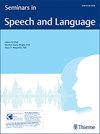An Investigation of Pulse Oximetry Levels during Swallowing in Healthy Adults and in Individuals with Severe and Very Severe Chronic Obstructive Pulmonary Disease.
IF 1
4区 医学
Q3 AUDIOLOGY & SPEECH-LANGUAGE PATHOLOGY
引用次数: 0
Abstract
To compare pulse oximetry (PO) levels during swallowing in healthy adults and adults with severe chronic obstructive pulmonary disease (COPD). Participants included two groups of 60 healthy adults, balanced for gender. The young group ranged from 18 to 38 years, and the older group from 60 to 87 years. In addition, there were 11 participants with COPD aged 43 to 82 years. PO levels were collected as each participant swallowed 10 mL of water, 10 mL of applesauce, and a piece of diced pear (three trials each). Analyses for the healthy groups revealed neither statistically significant main effects for bolus type nor interactions between gender and age. For between-subject effects, there was no main effect for gender, but there was a large main effect for age, and a gender and age interaction. In the group with COPD, there were no significant differences across bolus types; however, PO measures were consistently lower than the healthy groups for all bolus types. Healthy adults exhibited stable PO levels across bolus types. Adults with COPD, although exhibiting significantly lower PO levels, also remained stable. For clinicians who monitor PO measures, these results offer a more comprehensive understanding of the nature of these measures during swallowing in these groups.健康成人及重度和极重度慢性阻塞性肺疾病患者吞咽时脉搏血氧测定水平的研究
比较健康成年人和患有严重慢性阻塞性肺病(COPD)的成年人在吞咽过程中的脉搏血氧计(PO)水平。参与者包括两组60名健康成年人,性别均衡。年轻组年龄在18至38岁之间,老年组年龄在60至87岁之间。此外,还有11名参与者患有慢性阻塞性肺病,年龄在43至82岁之间。每个参与者吞下10粒时收集PO水平 mL水,10 毫升苹果酱和一块梨丁(各三次)。对健康组的分析既没有显示推注类型的统计学显著主要影响,也没有显示性别和年龄之间的相互作用。对于受试者之间的影响,性别没有主要影响,但年龄以及性别和年龄的交互作用有很大的主要影响。在COPD组中,推注类型之间没有显著差异;然而,在所有推注类型中,PO测量值始终低于健康组。健康成年人在各种药丸类型中表现出稳定的PO水平。患有慢性阻塞性肺病的成年人,尽管表现出明显较低的PO水平,但也保持稳定。对于监测PO测量的临床医生来说,这些结果可以更全面地了解这些组吞咽过程中这些测量的性质。
本文章由计算机程序翻译,如有差异,请以英文原文为准。
求助全文
约1分钟内获得全文
求助全文
来源期刊

Seminars in Speech and Language
AUDIOLOGY & SPEECH-LANGUAGE PATHOLOGY-REHABILITATION
CiteScore
2.40
自引率
0.00%
发文量
37
期刊介绍:
Seminars in Speech and Language is a topic driven review journal that covers the entire spectrum of speech language pathology. In each issue, a leading specialist covers diagnostic procedures, screening and assessment techniques, treatment protocols, as well as short and long-term management practices in areas such as apraxia, communication, stuttering, autism, dysphagia, attention, phonological intervention, memory as well as other disorders.
 求助内容:
求助内容: 应助结果提醒方式:
应助结果提醒方式:


